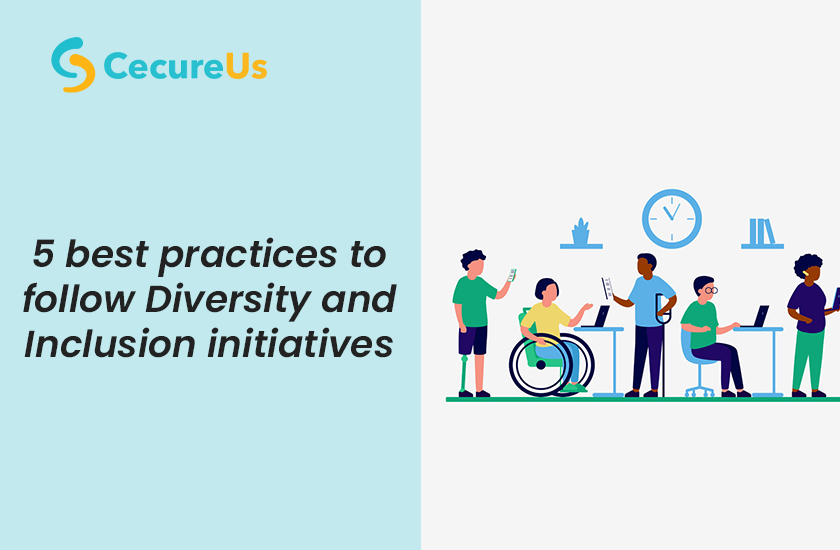
Top organizations often boast Diversity and Inclusion programs in their workplace. Global institutions are taking active measures to support Diversity and Inclusion and offer diligent representation to every caste, gender, religion, and minority. India is a land of many cultures and religions, which depicts an entirely different dynamic in Diversity and Inclusion in the workplace. Companies, alongside the government, have introduced several policies to create a diverse and inclusive workplace.
The law forms a strong core of every organization, boosting the confidence and productivity of its employees. Diversity in the workforce enhances innovative skills by 83%. Thus, the D&I practices should be made effective and long-lasting. Implementing them in an ad-hoc approach does not make an impact. We’ve created a systemized 5-step approach for complete D&I implementation in the workplace. Conducting well-rounded practices is vital for the employee’s well-being and sense of belonging in the workforce.
Five Best practices to follow for D&I initiatives
Diversity and Inclusion programs are a core part of employee engagement programs. A better environment for your employees creates more robust results for your organization.
A diverse work culture is full of opportunities and mutual development. It gives organizations a distinctive perspective and the power to execute unique operations. Follow this all-inclusive ABCDE approach for effective D&I implementation.
Audit
The primary step toward a diverse culture is understanding where your employees are. Managers must have a close relationship with the employees to note their desires and requirements. Employees should be able to voice their opinions and be comfortable in the workplace. Conducting a close audit and utilizing surveys and questionnaires is key to identifying the challenges and gaps in workplace inclusion programs. Questions in the survey should be used to record the employees’ and your audience’s demographics, including location, age, gender, religion, and preferences.
Buy-In
The next step after the audit is the buy-in. Once you have extensive results from the audit and surveys, organizations need to connect with their leadership and discuss the results from the audit. You need to describe the benefits of Diversity and Inclusion programs and depict how they would enhance the workforce’s productivity. The leadership will sponsor your D&I initiatives and start the program.
Champions
For a granular approach to your Diversity and Inclusion program amongst your workforce, you need to scout the talent and identify individuals responsible enough to run and head the program at both a macro and micro level. These Champions will oversee the D&I practices and ensure their proper implementation. The Diversity and Inclusion team will describe the procedure and steps of deployment. D&I programs are more than employing individuals from different cultures. They must have active representation at senior levels and positions of responsibility.
Forming a D&I team assists organizations in the proper implementation of the program. The team will set short and long-term goals, identify and fill gaps and challenges in the system, and conduct regular practices to maintain a healthy environment.
Discussions
Communication is highly effective in organizations. As the employees, contractors, and blue-collar workforce get a platform to voice their opinions, the Diversity and Inclusion programs reach new heights of success. Employees feel represented and heard with ongoing discussions. Organizations are up-to-date with present-time challenges in the workspace. Consequent actions can be taken on the spot to solve any issues.
Recurrent discussion on Diversity and inclusion creates a well-knit workforce, forming a deep understanding among the employees and managers. The active discussions will train the work population to effectively implement diversity and equality practices.
Equip, Enhance and Empower:
Diversity and Inclusion programs are not a one-time procedure. It’s a periodic, drawn-out process that interacts with employees personally. The practices connect with the workforce at different stages of their employment to leave a lasting impact beyond the organization. Employees should be equipped with the optimal structure, process, and policies for a thorough implementation of the D&I program. Information from the practices must stick with the employees from the beginning beyond the end of the employment life cycle.
Conclusion
D&I programs have become increasingly relevant as the active workforce in India becomes inclusive and diverse. Representation of minorities in posts of responsibility promotes the development of the country. Employees form the pillar of every organization. A healthy and diverse structure promotes the company’s growth, directly improving its productivity and results.
If this article interests you, leave a comment below or write to connect@cecureus.com. For more blogs and articles, visit our official website. Contact us for workshops and queries related to POSH, EAP (Employee Assistance Program,) and Diversity and Inclusion.




